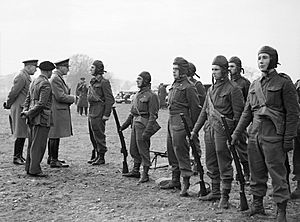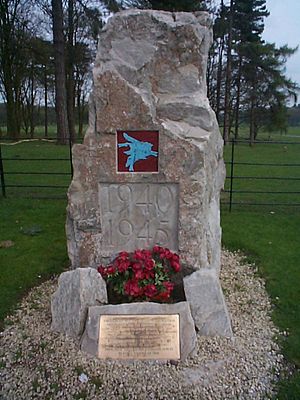Operation Colossus facts for kids
Quick facts for kids Operation Colossus |
|||||||
|---|---|---|---|---|---|---|---|
| Part of World War II | |||||||
 Men from No.2 Commando (No. 11 Special Air Service Battalion) who participated in Operation Colossus |
|||||||
|
|||||||
| Belligerents | |||||||
| Commanders and leaders | |||||||
| Major Trevor A. G. Pritchard | General Nicola Bellomo | ||||||
| Strength | |||||||
| 38 | Unknown | ||||||
| Casualties and losses | |||||||
| 1 killed in action, 1 wounded, 35 prisoners of war | |||||||
Operation Colossus was the first ever airborne mission carried out by the British military during World War II. It happened on February 10, 1941. This mission was a big step for Britain's new airborne forces, which are soldiers who jump from planes using parachutes.
The idea for British paratroopers came from Prime Minister Winston Churchill in June 1940. He was impressed by how well German paratroopers had done in the Battle of France. Training started quickly, but there weren't enough supplies or training places. The first group of paratroopers was a special unit called No. 2 Commando. They were later renamed No. 11 Special Air Service Battalion.
In February 1941, 38 members of this group, called X Troop, were chosen for Operation Colossus. The main goal was to test if British paratroopers and their equipment could work well. It also tested if the Royal Air Force (RAF) could drop them in the right place.
The target was a large aqueduct (a bridge that carries water) near Calitri in southern Italy. This aqueduct supplied water to many Italian people and important ports. Destroying it was meant to hurt Italy's war efforts in North Africa and Albania.
During the mission, some equipment didn't work, and some paratroopers landed in the wrong spot. This meant a lot of their explosives and a team of engineers were missing. But the remaining soldiers still managed to destroy the aqueduct. However, all of them were captured by Italian forces soon after. The aqueduct was fixed quickly, so the local people didn't run out of water. Even though the mission didn't stop Italy's war efforts, it taught the British many important lessons for future airborne operations. It also boosted the spirits of the new paratrooper units.
Contents
Why Britain Needed Paratroopers
The German military was very good at using paratroopers, especially during the Battle of France in 1940. They even captured a strong fort called Fort Eben-Emael using airborne troops. Seeing this success, the British government decided to create its own paratrooper units.
On June 22, 1940, Prime Minister Winston Churchill asked the War Office to look into creating a group of 5,000 paratroopers. But there were many challenges. Britain didn't have many gliders or enough planes to carry paratroopers. By August, only 500 volunteers could start training, even though 3,500 had signed up. This was because of limited equipment and aircraft.
A special training school for paratroopers was set up at RAF Ringway near Manchester in June 1940. It was called the Central Landing Establishment. The Royal Air Force provided some Armstrong Whitworth Whitley bomber planes to be changed into transport aircraft for paratroopers.
Developing these forces was difficult. Many officials worried that Britain couldn't spare enough soldiers to create a large paratrooper force, especially after the Battle of France. They also thought paratroopers would only be useful for small raids, not big battles. There were also not enough supplies, as all parts of the military were growing. Plus, there was disagreement between the Army and the RAF about who should be in charge of the new airborne forces.
Getting Ready for the Mission
By mid-1941, Britain still had few resources for airborne operations. The only unit ready was No. 11 Special Air Service Battalion. This unit had been formed from No. 2 Commando, a special forces group. They started intense parachute training in June 1940. Some commandos found the training very tough and refused to jump from planes.
On November 21, 1940, the Commando unit was officially renamed No. 11 Special Air Service Battalion. By December, they had finished their parachute training and were ready for action.
Even with limited resources, the British decided to carry out an airborne operation. This was to test the fighting skills of the battalion and their equipment. It also tested the RAF's ability to drop paratroopers accurately.
The target chosen was an aqueduct over the Tragino river in southern Italy. This aqueduct was the main water supply for about two million Italians and important ports like Taranto. The British hoped that destroying it would lower Italian morale and affect their war efforts in North Africa and Albania. The aqueduct was far from the coast and too strong for air bombing, so a paratrooper raid seemed like the best way to destroy it.
A small group of 38 men, called X Troop, was chosen for the mission. It included seven officers and 31 other soldiers. Major T.A.G. Pritchard led the troop. Three Italian-speaking interpreters joined them, including a civilian named Fortunato Picchi.
Training for the mission began in January 1941 and lasted six weeks. A full-size model of the aqueduct was built for practice. Sadly, one soldier died during training when he landed in an icy pond.
The plan was for six Whitley bombers from No. 51 Squadron RAF to fly X Troop from Malta to the target on February 10. Two other bombers would create a distraction by bombing railway yards in Foggia. After destroying the aqueduct, the troop would walk about 50 miles (80 km) to the coast. There, a submarine, HMS Triumph, would pick them up on the night of February 15.
The Mission Begins!
On February 7, X Troop flew to Malta without any problems. In Malta, they saw photos of the target. They learned there were two aqueducts, and they decided to target the larger one.
At 6:30 PM on February 10, the six Whitley bombers took off from Malta. Each plane carried one officer and five soldiers. The flight to Italy was smooth, with clear weather. The first plane reached the drop zone, about 500 meters (550 yards) from the aqueduct, at 9:42 PM. All six men and their equipment landed close to the target. The next four planes also dropped their men successfully.
However, two planes had trouble releasing their equipment containers because of ice. The sixth plane couldn't find the drop zone at all. It dropped its six men and most of the explosives two hours later, two miles from the aqueduct. These six men were Royal Engineer sappers, who were supposed to set up the explosives.
Despite these problems, the troop gathered the remaining equipment and got into position around the aqueduct. They found that the aqueduct's supports were made of strong reinforced concrete, not brick as expected. Major Pritchard worried they might not have enough explosives. After checking closely, he ordered most of the explosives to be placed on the western support and the rest on its base. They hoped this would cause enough damage. A small amount of explosives was also placed under a nearby bridge.
At 12:30 AM on February 11, the explosives went off. The western support of the aqueduct was destroyed, causing the aqueduct to break in half. The nearby bridge was also successfully destroyed. One soldier had broken his ankle during the landing, so he was left with a local farmer. The rest of the troop left the area at 1:00 AM, splitting into three groups and heading for the coast.
All three groups were captured within a few hours. Major Pritchard's group was seen by a farmer, who alerted the local police (carabinieri). Outnumbered and with little ammunition, Pritchard surrendered. The other groups were also found by Italian soldiers or civilians and captured after brief fights.
All the captured soldiers were taken to a prison in Naples and then to a POW (Prisoner of War) camp in Sulmona. However, the Italian translator, Fortunato Picchi, was taken to Rome. He was found guilty of treason and faced severe punishment on April 6, 1941.
Even if any of the groups had reached the coast, the submarine HMS Triumph would not have been there. One of the planes that created the distraction at Foggia had engine trouble and radioed that it was ditching near the Sele River, which was the pick-up spot. Fearing the Italians had heard the message and would set a trap, British officers decided not to send the submarine.
What Happened Next?
Destroying the Tragino aqueduct didn't really affect Italy's war efforts. The water in local reservoirs lasted until the aqueduct was repaired. However, the operation did cause some worry among Italians. The Italian government then put in place strict new air raid rules.
Major General Julian Thompson later criticized the operation. He said there was good planning for how to drop the paratroopers, but not enough planning for how they would escape. He also noted that not enough information was gathered about the aqueduct beforehand.
Despite these issues, the operation taught the British military valuable lessons. These lessons helped improve future airborne missions, like Operation Biting. It showed that paratroopers could be a threat to the Axis powers. It also gave a morale boost to the British military and its new airborne forces.
From a technical side, they learned that the equipment containers used were too soft. They would sag during flight and block the bomb bay doors. Future containers were made of metal to fix this problem.
Most of the surviving members of X Troop remained prisoners of war until Italy surrendered in 1943. However, two men managed to escape: Lieutenant Anthony Deane–Drummond and Corporal James Parker. Deane-Drummond escaped and returned to England in 1942. Parker escaped from the Sulmona POW camp, was recaptured, but escaped again and made his way back to the UK.
When the British airborne forces grew, No. 11 Special Air Service Battalion was renamed the 1st Parachute Battalion. It later became the core of the 1st Parachute Brigade in September 1941.
Images for kids




